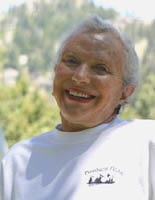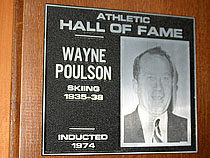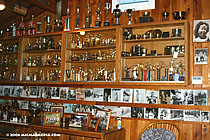 |
|
|
Follow Mark on Facebook for more stories |
||
|
Commemorating Poulsen Peak
Wayne Poulsen was born July 25, 1915, in Richmond, California. Two years later his family moved to Reno. When he was 12 years old, Wayne met someone who would influence his future dramatically. The scoutmaster of Wayne's Boy Scout troop, Jimmy Shaver, was renting a cottage from Dr. James Church, the University of Nevada professor who built the first Sierra weather station on Mount Rose and implemented the snow surveying system, which accurately measures water content in the snowpack. Shaver introduced Wayne to Dr. Church whose extensive research in snow and ice would inspire this young man to learn more about snow science. Within four years Poulsen's skiing abilities had improved to the point that he became the youngest of Dr. Church's cadre of volunteer snow surveyors who skied into the mountains each winter to record the snowpack's water content. Poulsen's competitive ski career launched in the winter of 1931 when the 16-year-old Reno High School student participated in the 32' Olympic tryouts as a Class C rated jumper at "Olympic Hill" (later renamed Granlibakken) near Tahoe City. The high-profile competition was part of the budding winter tourism efforts between the Tahoe Tavern hotel, the newly formed Lake Tahoe Ski Club, and the Southern Pacific Railroad. To entertain winter enthusiasts who arrived via SP's "Snowball Express" excursion trains, the Tahoe Tavern established a toboggan run and cross -country skiing course, with a jump constructed by 1927. The future ski champion helped perfect his outstanding skiing skills by observing the techniques of professional ski jumpers recruited to the Tavern's Recreational Center, as well as at Truckee's Hilltop resort where a large scaffold ski jump was built in 1928.
During the 1930s, Poulsen was a celebrated athlete who performed spectacular ski jumps at exhibitions in Berkeley in 1934, the Oakland Auditorium in 1935, the Los Angeles Coliseum in 1938, and during the International Ski Federation Championships that opened the 1939 San Francisco World's Fair on Treasure Island. In 1938 Poulsen completed a scientific survey, later published by the American Geophysical Union, which "classified snow conditions in the Sierra as they would apply to the development of winter sports and resorts areas." Dr. Church, then president of the International Snow and Ice Congress, sponsored Poulsen's efforts. The report ultimately provided the blueprint for the development of many Tahoe-Truckee ski areas, including Sugar Bowl ski resort at Donner Summit. Ski historian Bill Berry acknowledged that Poulsen's findings were "another great step in the forward march of [Sierra] skiing." Wayne Poulsen made many trips up and down the Truckee River Canyon, giving him ample time to marvel at the distant mountain peaks lording over the meadows of Squaw Valley. On a summer fishing trip in 1932 he entered the valley for the first time, and after further exploration, decided to acquire and develop Squaw Valley as "a mountain community dedicated to skiing as a way of life." Indicative of Wayne Poulsen's "can-do" attitude, it was a remarkable vision for someone still in high school. In 1938 he took an option to buy land in the valley from Southern Pacific. A ski champion's life isn't all play. Prior to U.S. entry into World War II, Poulsen earned a position with the Canadian Royal Air Force as a pilot. Pearl Harbor soon catapulted America into the war and he joined the U.S. Air Force as a flight instructor. His exceptional flying ability would soon earn him a position as a lead pilot for Pan American Airways. While skiing at Sun Valley, Idaho, he met Gladys "Sandy" Kunau and they were married in August 1942. Wayne Poulsen flew three campaigns during the war and attained the rank of Lieutenant Colonel. Poulsen traveled all over the world, but he never gave up on his dream of operating a ski area in Squaw Valley. Over the years he purchased nearly 2,000 acres of the valley floor where he would bring the family tent camping in summer. Wintertime was another story. In order to bring skiing friends and possible investors into his remote alpine valley, Poulsen purchased several World War II landing crafts called weasels, which had been designed by the military for use on beaches in the Pacific Islands but worked fine on snow.
Wayne's wife Sandy was with her husband every step of the way. She birthed eight children and kept the hearth warm. During Truckee's "Windows on History" event in May 2005, Sandy Poulsen told a small group of us how KT22 got its name. "One winter during the 1940s, soon after we had purchased the valley from Southern Pacific, Wayne and I hiked up to ski one of the more challenging slopes." she recalled. "Wayne was a great skier and he had no trouble skiing the steep pitch. He kept calling for me to start making turns, but I was too afraid. I ended up descending by skiing side-to-side and making kick turns. Wayne counted 22 kick turns, and so we named it KT22." Wayne Paulsen loved Squaw Valley and lived his life defending its integrity. Among his many honors, Wayne Poulsen was elected to the U.S. National Ski Hall of Fame in 1980. In 2004, Sandy Poulsen accepted a Lifetime Achievement Award from the Squaw Valley Institute on behalf of herself and her husband. When the U.S. Board on Geographic Names committee unanimously approved Poulsen Peak on May 12, 2005, they bestowed a deserving honor on a legendary ski pioneer and his proud family. |
|||||||||||||||||
|



